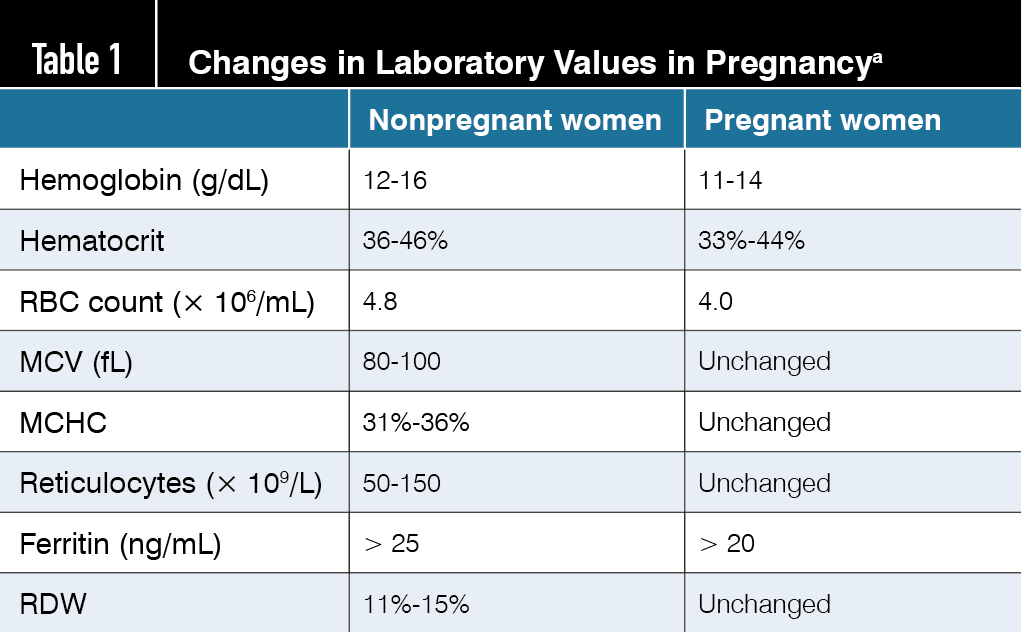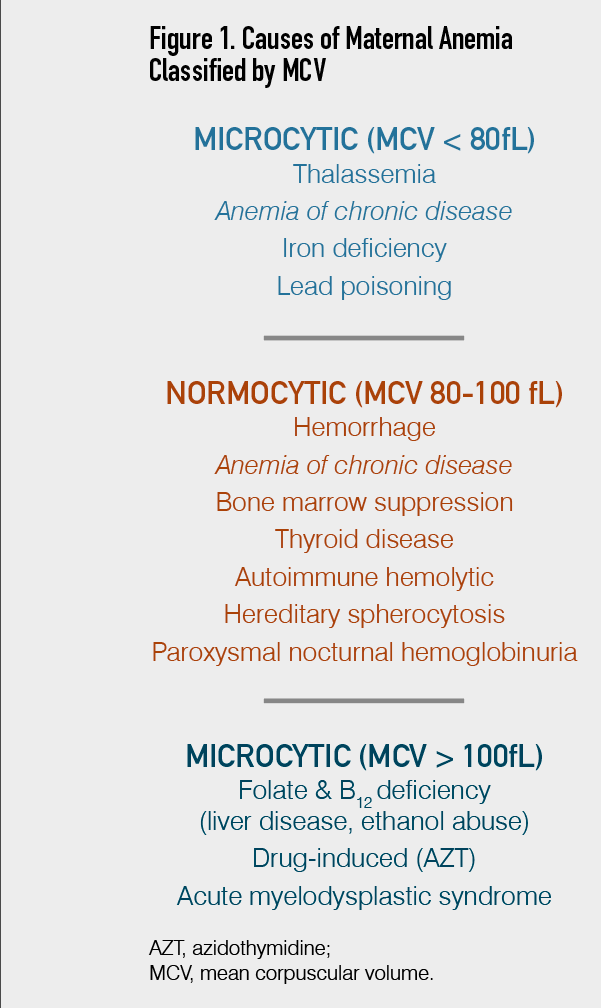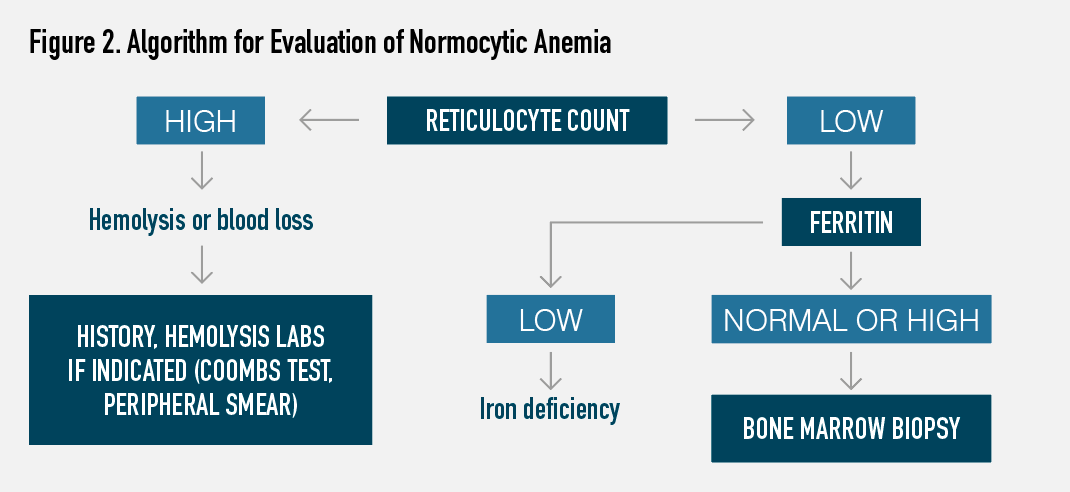Protocols for High-Risk Pregnancies, 7th Edition: Snapshot: Protocol 11 - Maternal Anemia
The protocol presented provides an algorithm for the initial evaluation of anemia in pregnancy, with treatment algorithms for the most common causes in pregnancy.
SYNOPSIS: A comprehensive review of all causes of anemia may be intimidating, and many available algorithms are not high yield when evaluating pregnant women. The protocol presented provides an algorithm for the initial evaluation of anemia in pregnancy, with treatment algorithms for the most common causes in pregnancy. Women who do not meet one of the definitions provided below are best managed in consultation with a hematologist.
Definition
During a singleton gestation, plasma volume doubles (increasing approximately 1000 mL) and red blood cell (RBC) volume increases by 25% (300 mL), with RBC production slightly behind plasma expansion. This results in a physiologic dilutional anemia of pregnancy, which reaches a nadir during the late second to early third trimester (Table 1).
The Centers for Disease Control and Prevention defines anemia as a hemoglobin (Hb) below the fifth centile for a healthy, iron-supplemented population. This translates to a threshold of Hb less than 11 g/dL in the first and third trimesters and less than 10.5 g/dL during the second trimester. Rates of anemia in pregnancy vary widely between different populations and socioeconomic classes.
Table 1. Changes in Laboratory Values in Pregnancya
MCHC, mean corpuscular hemoglobin concentration; MCV, mean corpuscular volume; RBC, red blood cell; RDW, red cell distribution width.
aAdapted from ACOG Practice Bulletin No. 107, 2009, with permission from Lippincott Williams & Wilkins.

Consequences
In developed countries, maternal anemia has been associated with increased risk of preterm birth and low birth weight infants, as well as neonatal and perinatal death. In addition, maternal complications associated with anemia include preeclampsia, cesarean delivery, postpartum depression, and an increased likelihood for transfusion, either intrapartum or postpartum, despite equivalent blood loss. Women with anemia are asymptomatic or describe vague symptoms such as fatigue and palpitations; therefore, screening for anemia during pregnancy is recommended regardless of symptoms.
Diagnostic Work-up and Treatment
Causes of anemia may be classified by pathophysiology, such as comparing acquired versus inherited causes or mechanisms of anemia such as decreased RBC production versus increased destruction.
Figure 1. Causes of Maternal Anemia Classified by MCV

In clinical practice, more often the evaluation of maternal anemia starts with the mean corpuscular volume, based on which anemias are defined as microcytic (<80 fL), normocytic (80-100 fL), or macrocytic (>100 fL; Figure 1).
Macrocytic Anemia
Figure 1 shows the appropriate work-up for the search of causes in the presence of macrocytic anemia.
VITAMIN B12 DEFICIENCY is rare, as most healthy individuals have 2 to 3 years’ storage available in the liver. However, vitamin B12 deficiency can be encountered in individuals who have undergone bariatric surgery with partial gastric resection and are noncompliant with recommended vitamin B12 supplementation (350 µg/day sublingually plus 1000 µg intramuscular every 3 months if needed), in individuals with pernicious anemia (an extremely uncommon autoimmune disease in women of reproductive age that is diagnosed by the presence of serum intrinsic factor antibodies), and in individuals with malabsorption (eg, Crohn disease or ileal resection).
FOLATE DEFICIENCY is less common today given the supplementation of foods with folate and universal folic acid supplementation in pregnancy.
Recommended folate requirements are 400 µg/day during pregnancy, with higher doses recommended in the presence of multiple gestations, with hemolytic disorders such as sickle cell anemia or thalassemia, and in patients taking antiepileptic drugs or sulfa drugs (eg, sulfasalazine).
In addition to macrocytic anemia, folate deficiency may also cause thrombocytopenia. If a diagnosis of folate deficiency is made or the woman had a prior pregnancy affected by a neural tube defect, the recommended dose of folic acid is 4 mg/day. Anemia due to folate or B12 deficiency should respond briskly, with an elevated reticulocyte count, within 4 to 7 days of beginning treatment. In the case of macrocytic anemia with normal folate and vitamin B12 levels, a consultation with a hematologist is indicated for bone marrow biopsy.
Normocytic Anemia
The recommended laboratory evaluation for normocytic anemia is displayed in Figure 2. A high reticulocyte count indicates either hemolysis or blood loss with resultant bone marrow activation.
Figure 2. Algorithm for Evaluation of Normocytic Anemia

If a normocytic anemia with an elevated reticulocyte count is found, a careful history and evaluation of laboratory studies for hemolysis, such as Coombs test, peripheral smear, and lactate dehydrogenase level, are recommended.
A normal or low reticulocyte count in the setting of anemia raises concern for iron deficiency (a ferritin level < 10-15 μg/dL is diagnostic) or bone marrow suppression/disorders.
Low reticulocyte count with normal or high serum ferritin levels can be seen in the presence of hypothyroidism or chronic disorders, such as inflammatory bowel disease, systemic lupus erythematosus, granulomatous infections, malignant neoplasms, and rheumatoid arthritis. Hematology consultation for further assessment is indicated in these circumstances.
Mixed nutritional deficiencies (folate and iron) may lead to normocytic anemia in pregnancy, but routine supplementation makes the probability of such a scenario low.
If concern for a mixed nutritional deficiency does arise, the red cell distribution width (RDW), a marker of increased variability in red cell size or anisocytosis, is a useful indicator because an RDW greater than 15% indicates the presence of nutritional deficiencies.
Microcytic Anemia
Most cases of microcytic anemia in pregnancy are due to iron deficiency anemia. Evaluation of a ferritin level should be the next step in evaluation. Serum ferritin is the most sensitive and specific screening test for iron deficiency (with < 10-15 μg/dL indicating depleted iron stores).
If serum ferritin is normal or high, the next step is hemoglobin electrophoresis to evaluate for a thalassemia. Such situations usually warrant consultation with a hematologist for further evaluation and bone marrow biopsy as indicated.
Iron Supplementation in Pregnancy
In a typical singleton gestation, maternal iron requirements (including blood volume expansion as well as fetal and placental requirements) average 1 g for the entire pregnancy, with this requirement further increased in the setting of multiple gestations.
In a landmark study of healthy, nonanemic, menstruating young women who agreed to bone marrow biopsy, 66% had inadequate iron stores. For the above reasons, and because gastrointestinal adverse effects (AEs) of oral iron supplementation (constipation, nausea, and diarrhea) are negligible with doses less than 45 to 60 mg, supplementation with elemental iron (30 mg/day) is recommended for all pregnant women in the United States, regardless of indices. Supplementation should be continued until 3 months postpartum in areas with high prevalence of anemia.
A review of randomized clinical trials (most performed in Western countries) shows that routine supplementation in nonanemic women results in higher maternal Hb levels at term and 1-month postpartum, higher serum ferritin levels, lower rates of anemia at term (relative risk [RR]=0.26) and of iron deficiency anemia in particular (RR=0.33), and higher serum ferritin levels in the infants.
However, no differences are noted in most clinical outcomes (such as preterm birth, preeclampsia, or need for transfusion), birth weight, small for gestational age, perinatal mortality, or need for admissions to neonatal intensive care unit.
Treatment of Iron Deficiency Anemia
Compared with routine supplementation in pregnancy, higher doses of iron are required for the treatment of maternal anemia (up to 200 mg/day).
ORAL IRON therapy is most often utilized, with a list of the most commonly available formulations in Table 2. Enteric-coated forms should be avoided because they are poorly absorbed. Absorption is increased by intake of iron on an empty stomach and with vitamin C or orange juice.
Table 2. Oral Preparations for Therapy of Iron Deficiency Anemia

Although several trials have been conducted to compare iron formulations, it is not possible to assess the efficacy of the treatments due to the use of different drugs, doses, and routes. Gut absorption decreases with increasing doses of iron; therefore, it is best to divide the total daily dose into 2 or 3 doses.
A relationship is present between dose of oral iron and gastrointestinal AEs, with worsening of symptoms as dose increases, with such AEs leading to discontinuation of therapy in 50% of women.
To encourage adherence, it is important to minimize AEs by increasing the dose gradually, with larger doses in the evening, and considering the use of an iron sulfate elixir, which allows more gradual titration of dose. Stool softeners are often required to prevent constipation.
Serum reticulocyte count should be elevated within 7 to 10 days of treatment initiation, with a slower improvement in Hb levels. Expect Hb deficit to halve in 1 month and normalize 6 to 8 weeks after initiation of treatment. To replenish iron stores, oral therapy should be continued for 3 months after the anemia has been corrected.
INTRAVENOUS (IV) IRON therapy is generally reserved for women who cannot or will not take oral iron preparations. Hb indices are equivalent after 40 days of treatment in women receiving IV iron therapy as compared to those receiving oral therapy, but the rate of rise is more rapid in women receiving IV therapy.
Randomized trials have not shown significant differences between the 2 forms of supplementation in need for maternal blood transfusion, in neonatal birth weight, or in neonatal anemia, and findings have demonstrated a preference for oral supplementation among most women.
Therefore, IV therapy is indicated only in patients with severe anemia with intolerance to oral therapy or malabsorption. Iron dextran is associated with a greater risk of anaphylaxis and is not recommended in light of other available formulations with a lower risk of allergic reaction.
ERYTHROPOIETIN is not indicated in the treatment of iron deficiency anemia unless the anemia is caused by chronic renal failure or other serious chronic medical conditions; it is expensive, with many associated AEs, so its use should be reserved for treatment by a hematologist.
BLOOD TRANSFUSION is indicated only for anemia associated with hypovolemia from blood loss or in preparation for a cesarean delivery in the presence of severe anemia.

S4E1: New RNA platform can predict pregnancy complications
February 11th 2022In this episode of Pap Talk, Contemporary OB/GYN® sat down with Maneesh Jain, CEO of Mirvie, and Michal Elovitz, MD, chief medical advisor at Mirvie, a new RNA platform that is able to predict pregnancy complications by revealing the biology of each pregnancy. They discussed recently published data regarding the platform's ability to predict preeclampsia and preterm birth.
Listen

